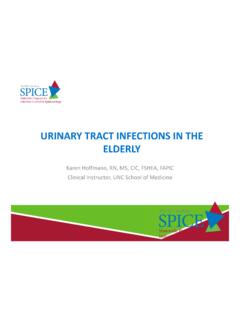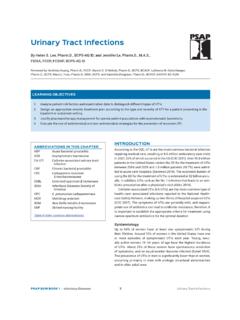Transcription of Urinalysis Clinical Skills Guidance - University of Glasgow
1 School of Medicine, Dentistry & Nursing Urinalysis Clinical Skills Guidance Learning Objectives Understand the importance of Infection control protocols when carrying out a simple Urinalysis test Describe the reasons for specimen collection Discuss how to obtain a specimen of urine from a patient Consider the procedure and steps required to carry out a simple Urinalysis test Be able to carry out a simple Urinalysis test in a simulated or Clinical setting. Understand the abnormal findings from a Urinalysis test Introduction Urinalysis is a common investigative procedure which may aid a diagnosis .
2 A relevant patient history and appropriate further investigations should be performed if an abnormal result is obtained. Urinalysis provides results within minutes and may aid the detection of a number of diseases including: Diabetes Renal Stones Urinary Tract Infection Infection Control Protocols Please refer to the prevention and control of infection manual for updates or changes in policies or procedures locally or nationally. Responsibilities Healthcare workers must adhere to the prevention and control of infections policy. Healthcare workers immunisation must be up to date.
3 All HCW s involved in specimen collection must be immunised against the Hepatitis B virus. Ensure all equipment used is safe and leak proof specimen containers are used. Standard Precautions All cuts and abrasions must be covered with waterproof dressings Wear gloves when in contact with blood or body fluid contamination If there is a risk of splash, face protection must be worn Wash hands after procedure regardless of whether gloves are used. All spillages of blood and body fluids must be decontaminated appropriately. Reason for specimen collection To aid diagnosis of a disease For the purpose of screening in health to facilitate cancer diagnosis , staging and type.
4 To monitor the effects of treatment . To permit laboratory culture to identify pathogenic micro-organisms and determine drug sensitivity. Types of specimens collected Mid stream specimen of urine (MSSU) catheter specimen of urine (CSU) Mid-Stream Specimen of Urine (MSSU) An MSSU must be obtained in a bottle containing boric acid. These are normally red top bottles. When collecting the specimen you should request that the patient attends to personal hygiene in the genitalia area prior to collection. The patient is asked to commence passing urine initially, and then collect a small sample into a sterile bowl before allowing the patient to pass the remainder into the toilet or a bedpan.
5 The urine is then transferred into the specimen container. Equipment required for mid-stream urine specimen: catheter SPECIMEN OF URINE (CSU) The following equipment is necessary to obtain a CSU: - Disposable gloves A sterile needle A sterile syringe Two alcohol-impregnated swabs A boric acid urine container (red top bottle) Sharps disposal bin Procedure Explain the procedure to the patient and ensure that you have obtained consent Carry out hand hygiene Apply disposable gloves Wipe the catheter sampling point with an alcohol-impregnated swab Connect the needle and syringe and insert into the sampling point.
6 Gently withdraw the required amount of urine necessary for the test. Transfer the urine into a sampling bottle immediately Dispose of the sharp into a sharps disposal unit immediately after filling the urine container. Ensure the container lid is sealed prior to moving the specimen. Excess urine maybe disposed of into the toilet bowl. The sampling port should be wiped with an alcohol-impregnated swab at the end of the procedure Dispose of equipment into a waterproof bag and place it into the patients outside bin Hand hygiene must be carried out following procedure Ensure that the specimen container is labelled with the correct patient details prior to leaving their home.
7 Ensure the patient s privacy and dignity are maintained throughout procedure. Ensure the patient is aware on how to obtain their results Details of the specimen should be recorded in the patients notes Ensure the appropriate laboratory form is completed and labelled appropriately Specimen Collection Confirm the identity of the patient Explain the procedure to the patient and obtain consent. Check you have the appropriate container for the test. Check the container lid securely fits the specimen container. Check the container is free from obvious contamination. Perform hand hygiene to prevent contamination of the specimen.
8 Gloves must be worn prior to commencing the procedure. Take all the required equipment to the patient. Throughout the procedure ensure patient privacy. As soon as the specimen is obtained, secure the lid to the container. Every effort must be made to prevent contamination of the outside of the container. Thank the patient for their cooperation and inform them when the result can be expected and who to contact to obtain GP. Dispose of any excess urine in the toilet bowl and place any receptacles used in a waterproof disposal bag and place it directly into the patients OUTSIDE bin. Remove personal protective equipment.
9 Decontaminate hands. Label the sample prior to leaving the patients home confirming the patient s details. Name, , specimen type, date and time should be included on the container. If possible place the specimen in a sealed plastic envelope. Decontaminate hands. Document in patients notes that the specimen has been obtained. The specimen should be transported to the appropriate collection area with the suitable laboratory form. The appropriate laboratory form should be folded and placed within the sleeve of the bag. The patient s details should not be visible to the outside ensuring confidentiality is not breeched.
10 Should the container leak a new specimen must be obtained and an incident form completed. Specimen Forms Specimen forms vary depending on the type of test required. When screening a specimen for infection a bacteriology form should be completed. Clinical reasons should be included when giving a summary of details you may include the patient has been experiencing pain on passing urine (dysuria), frequency of micturition or the patients urine may be fouls smelling. Hazardous Labelling of Specimens All specimens pose a risk of infection but a where a specimen is known or suspected to contain a transmissible agent then the appropriate labelling should be used to highlight the danger.












